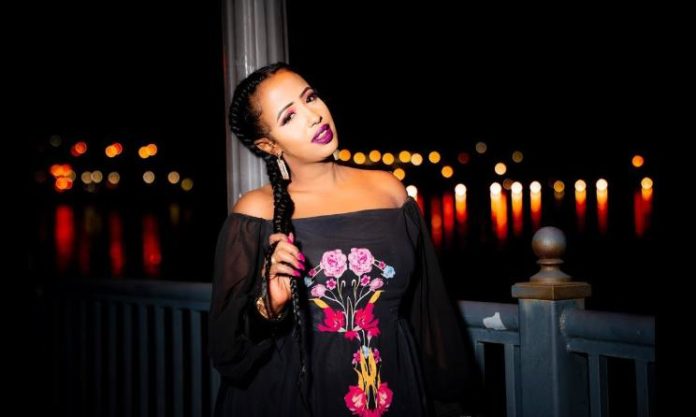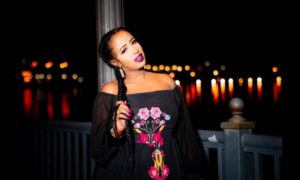Singing is not only an integral part of daily life for Somali women but also a medium through which they can express their grievances and criticise paternalistic social norms that have solidified men’s hegemony over women and limited their social participation to certain stereotyped roles. From a mother’s lullabies to work songs, folkloric dance lyrics and the famous buraanbur genre, Somali women’s sung poetry conveys messages and stories about their status in society.[1]
Engendering social reform through lyrics
When looking at the below folkloric lyrics[2], one can see that Somali women refused to be bystanders in the debate for social change. They led an awareness campaign through their sung poetry to engender the kind of social reform they aspired to achieve.
In the following example, which scorns the expected role of a bride, a woman warns her female friend, geelo in Somali, about the predicaments she would face on the first night of her marriage.
Haddaba geeladaydii (Oh, my dear geelo)
Ila garan ogtaydii (My graceful dancing partner)
Caawaba dirqaad geli (Tonight, you will enter a forced bondage)
Dirqi wiil yar baad geli (The bondage of a young boy)
Dabka iga shid baad geli (Who will command you to make the fire for him).
To which her friend replies:
Hadaba qayradaydii (Oh my dear geelo)
Caawa qaday Alla I qaad (Tonight I will abstain from eating)
Qabri la igu duuduub (A doomed one, I am hurled into a grave).
Polygamy is another topic that Somali women frequently crticise in their sung poetry, as reflected by the following well-known lines of the ‘Godadle’ song, which women sing when pounding grain with a mortar and pestle:
Godadle godadleeyow godadle (Oh, you man with many hovels)
Godadle xiisaalow godadle (Oh, you with a fickle desire, you with many hovels)
Kii garreey gubayow (Oh, you who tortured Garreey)
Kii gadh ceesaanlow (Oh, you with a goatee beard)
Kii gafuur dibilow (Oh, you with a frowned face like an ox)
Gabadh yar uu gabayuu (Oh, you man who after neglecting his young wife)
Uu guduudiyayuu (And beaten her red)
Uu gogosha ku cunayuu (And killed her with nagging in bed)
Way gabtaa yidhiyee godadle (Then accused her of ignoring him).
The poetry of Somali women does not spare young single men of what some see as mischievous behavior and an indifferent attitude towards women. The following lines accuse young single men of being only concerned about their bellies and not taking part in domestic chores that women usually attend to.
Doobow dibiro aylow (Oh, single man, all you care about is filling your belly like a dog)
Diixaax waraasaalow (Oh, how content you are with your life)
Dibi ceel ka soo fulayow (Like a bull just returning from its watering hole)
Waxa doob iyaa rara (Oh, how I wish that the single man was loaded like a camel)
Rara oo rakaabiya (Loaded with full water containers)
Dhanba laba sideedaad (Two loads of eight containers on one side)
Dhanba laba sagaalaad (Two loads of nine containers on the other)
Suudiga dharaareed (And then drive him through the hot, harsh desert)
Soddohdiina daba dhiga (With his mother-in-law walking behind him prodding him to speed up).
The plight that befalls women who give birth to girls rather than boys is another topic that Somali women address. In a paternalistic society, Somali people tend to value boys over girls, with men often being angered when their partners give birth to girls. There are also instances where men leave their wives if they bear girls.
In one widely-known folk song, the character Qaladla Nur, who gave birth to only girls one pregnancy after another, sees her husband mount his horse and depart in the early morning, after she delivered another girl. Lamenting the actions of her husband, Qaladla seeks comfort by talking to her new baby girl, Hubeeya, about her plight:
Hubeeyaay aabahaa
Hubka qaadayoo
Heensaha duleedka dhigay (Oh Hubeeya, your father has taken his weapons and saddled his horse outside the homestead)
Ee awal ayaa uumayeen
Ilaah ahayn (But who created her but God?)
Hubeeya Allaa uumayee ayaa
Loogu umal qabaa (Allah alone has created Hubeeya. So why blame anyone else?)
Qaladla then turns to her eldest daughter to tell her that since her husband has abandoned her, she also intends to leave her family and return to her parents.
Wallee Qaafo Rooxaay (Oh, my daughter Qafo Roxa)
Haddaan aabbahaa i rabin (If your father doesn’t love me)
Wallee ruuxayga ruuxaaga uma daayacoo (Then in the name of God, I will not sacrifice my life for you)
Wallee reerahayagii ramado wawgu tegi (I will join my father’s family in their homestead in Ramado).
But when on another occasion Qaladla gives birth to a baby boy, her husband becomes intoxicated with happiness, and, being a man of little wealth, he raids the camels of another clan to host a feast and celebrate the arrival of his first son. Deriding the action of raiding and looting to celebrate the birth of a son, Qaladla addresses her baby boy with sarcasm:
Maxaan rayayeey (Oh, how fortunate we have become)
Maxaa reer la ii rokolay (How much misery have we caused other families?)
Maxaan awrtii ogaadeen
Aamin cunay. (Oh, Amin, my son, how many of the Ogaden clan’s camels have we consumed?)
Somali women, therefore, do not miss an opportunity either to criticise the social norms that pigeonhole them into certain roles or to express their opinion about how they want things to be. The following lyrics are often chanted while pounding grain – a job that usually requires two women. The women sing the lyrics together, with one taking the lead and the other repeating the chorus line.
The following lines describe the type of man that a woman should marry:
Saddex kaaga digaa (I warn you against three things)
Kaaga dayriyayaa (I admonish you not to do them)
Kaaga diin dhigayaa (Adhere to my advice like a religion).
She continues warning her friend against marrying a short man, or a tall man, critiquing each for tasks they cannot do due to their physique. She also warns against marrying a hero, who, she says, will die young and leave her behind a widow.
Ninka geesi ha guursan (Do not marry a hero)
Oo waxaanad u guursan (And why should you not marry him?)
Marka geela la qaado (For when the camels are looted)
Gabgab buu u orddaa (He rushes out recklessly)
Gaabidaa la dhigaa (And he is killed in battle)
Gabadh buu ka tagaa (He leaves behind a young widow)
Gablan buu ku badaa (And leaves her helpless and single).
She then describes the man she considers to be the perfect match for a woman to marry: one who cares for his parents, speaks softly and observes prayers. She then concludes that if a woman cannot find such a man, she should stay single and childless until her death.
Other work songs include those sung when churning butter. In melodic voices, women talk to the milk container, known as haan, urging it to ferment quickly while scolding it for being obstinate. The songs also highlight the amount of work involved in the process as well as the value of butter.[3]
With children’s lullabies, Somali mothers entertain and soothe their babies while working. The mother does not only sing to her child for the sake of entertainment or to lull it to sleep; in a patriarchal society, she also teaches her son about the merits of his ancestry and shares with him her future dreams for his life:
Hoobeey hoobeey heeyaa
Hooyo ab iyo ababa samow hoowaa
Hooy adeero wanaagsanow hoowaa (Oh, my son, you who claims to be the scion
of a dignified clan and a good father. Oh, my son, you who claims to have notable uncles)
Hoobeey hoobeey heeyaa
Hooyo adoo xeebaha gudbaaya
Hooyo adoo Xamar Yare ku joogaa
Hooyo adoo gabdho xoominaayaa
Ayaan xalay kugu riyooday. (Oh, my son, I had a dream about you last night. Riding regally on your horse Xamar Yare. Galloping along the coast, chasing and rounding up girls)
Finally, some of the most famous lines invoked when talking about Somali folk poetry are those that women sing while making mats, or kabad, for their nomadic huts.
Each line has a message to convey:
Awdal laga keenyeey
Alalag dheereey
Il bari looga soo oriyey (The mat which has been brought from awdal. What a fanfare you cause. Oh, how much they sing your praises. In the farthest corners of the East)
Koronkor cuni maynoo
Kariba maynee
Karuur geel ma la hayaayey (We cannot eat millet. Which looks like a hopper band. Why not offer us sour camel milk?)
Naagta kabada leheey
Kaalin culuseey
Adaan kayd hore u sii dhiganeey (Oh, you woman, owner of the mat. Why do we find your work so heavy? Because you didn’t save provisions for such a job.)
Somali women have hundreds of similar sung poems for everything they do and every event in which they partake. They have also played a remarkable role in Somali folk dances. There is rarely any dance in Somali culture that doesn’t include women. Names of celebrity female dancers and singers continue to abound in the Somali folk tales. Among the traditional dances that women partake in include sayalici, hirwo, dhaanto and modern dance songs such as ‘Hiddo’ by Ubah Dahir. There are also women-only dances such as heelo yar-yar and dhexmaro.
According to John William Johnson[4] and myself, this strong female singing tradition explains why, when modern Somali music was born in 1943 and pioneered by Abdi Deeqsi Warfa (Abdi Sinimo) with his balwo songs, there was Khadija Iyeh Dharar (Khadijo Balwo) by his side as his partner. She even borrowed the genre’s name, balwo, as her nickname.
Modern female singers
Khadija Balwo was soon followed by other trailblazers such as Shamis Abokor (Guduudo Carwo), the first Somali woman to record a song for Radio Hargeisa in British Somaliland, and Khadija Abdullahi Daleys, who became the first female singer in Mogadishu (Italian Somaliland). Dalays was honored in Minnesota shortly before her death.
During the golden period of Somali music from the 1960-80s, Somali female singers seemed to have outnumbered men. Iconic singers who captivated music lovers during this era included Fadumo Abdillahi (Maandeeq), Halima Khalif (Magool), Zainab Haji Ali (Baxsan), Farhiya Ali, Hibo Mohamed (Hibo Nuura), Sahra Ahmed, Amina Abdillahi, Khadra Dahir, Zeinab Egeh, Shankaroon Ahmed, Fadumo Qasim Hilowle, Maryan Mursal, Khadija Mahamoud (Qalanjo), Qamar Abdillahi (Harawo), Saado Ali Warsame, Saafi Duale, Marwo Mohamed, Ruun Haddi Saban, Amina Fayr, Kinsi Haji Adan and many others of the celebrated Waaberi band.[5]
Famous Waaberi folk dancers who have won awards in Africa and elsewhere also include Khadija Qalanjo, Siteey Mohamed Nur (Siteey Ma Noogto), Feynuus Sheikh Dahir and others.[6]
The decline of women’s role in music
When the Somali government collapsed in 1991, female artists fled the country in droves, while those who remained in the homeland stopped singing after radical groups such as Al-Shabab took control in 2009. The daring few who remained behind and attempted to practice some form of music were heavily punished. Concerts were banned and even male musicians turned away from performances and towards religious conservatism.
Although there is still resistance to music by many Somali people, as seen in the rejection of Nasteexo Indho to perform in Hargeisa in August 2016, and the failed attempt by religious clerics to prevent the holding of a concert by Kiin Jama Yare in April 2018 in Mogadishu, the Waaberi artists who emigrated overseas have revived Somali music in many parts of the world – and a new generation of diasporic female artists have taken up the mantle.
Among the most celebrated singers from the diaspora are Zainab Laba Dhagax, Deeqa Ahmed, Farhiya Fiska, Naseexo Indho, Hodan Abdirahman, Kiin Jaamac Yare, Halimo Gobaad, Rahma Rose, Nimo Dareen, Nimo Yasin, Idil Barkhad, Amina Faarax (Amina Gacanla) and others.
In the city of Hargeisa, Sahra Halgan, a famous Somali singer, created a live music and cultural revival centre known as Hiddo Dhawr in 2014. She met resistance in opening the centre. A few years before that, an attempt to reopen the Hargeisa National Theatre was foiled by religious groups, while the National Theatre of Mogadishu still lies in ruins.[7]
Another woman who played a significant role in the revival of Somali music is the former broadcaster Nimo Samriye, who promoted music through the weekly Fanka iyo Suugaanta (Arts and Literature) programme, which she hosted on Somaliland National TV. In Mogadishu, the well-known singing competition known as Heesaha Hirgalay, run by the National Theatre in the 1970s, was revived by the Somali Information Ministry in 2014 with a number of female participants.[8]
Somali women’s pivotal role in the preservation of music and singing has also been safeguarded by wedding ceremonies both in Somalia and abroad. Weddings, traditionally, were cultural spaces where women and men performed dances and sang together, but as Somali society turned more conservative through the years, men and women became segregated during wedding ceremonies. As a response, women made their parties as boisterous as they could, with lots of music and dance.
Second-generation Somali women, predominantly living in the West, are also extending Somali music into new frontiers, such as the singing sisters known as Faarrow, who are working in the Afropop genre. Finally, one of the missing links in Somali women’s otherwise remarkable contribution to music was also recently filled by Fawzia Haji, who has become the first Somali woman DJ working under the stage name DJ Fawz.
The way forward for Somali women’s music
Looking at the Somali music landscape today, one cannot miss the robust role that women have played in refashioning classical music and in pushing social boundaries and confronting cultural taboos. Due to the presence of large Somali communities in the diaspora, where young female talent finds more freedom and opportunities to follow and fulfill their passion in music, and where the explosive growth of social media helps to amplify women’s voices, one can only expect this trend to continue.
In Somalia today, female musicians are pushing back against conservative pressure and breaking new ground for themselves. Apart from Sahra Halgan and her revolutionary music house Hiddo Dhawr in Hargeisa, which has created a positive outlook among the youth, another legendary female musician has embarked on an ambitious project in Mogadishu. Muslimo Hilowle, one of the first Somali women to play musical instruments professionally and who emerged as a musician in Waaberi, recently started promoting the music of girls at an orphanage in the Boondheere neighbourhood.
Speaking to the media, Muslimo expressed hope to find talented girls among the group of orphans to become professional musicians in the future. Given the tough environment in which Muslimo is teaching music to girls, one cannot fail to recognise her dedication with awe and respect. It is also a reminder that Somali women’s music will find its own ways to survive and grow.
Resources and citations:
[1] Mohamed Haji Mukhtar. Historical Dictionary of Somalia. The Scarecrow Press Inc., 2003
[2] Poems collected during interviews with a number of women. Mainly from Asha Adan Awale and Asha Dahir Bahal.
[3] https://www.facebook.com/FreeAdvertisingAvailable/videos/1678885589040888/(link is external)
[4] John William Johnson. Heelloy: Modern Poetry and Songs of Somalis. Indiana University Press, 1998
[5] Sohonie, Vik. Uncovering Somalia’s forgotten music of the 1970s, 2017: https://www.aljazeera.com/indepth/features/2017/07/uncovering-somalia-forgotten-music-1970s-170704123301195.html(link is external)
[6] Goth, Bashir (2015). Magool: The Inimitable Nightingale of Somali Music. Bildhaan: An International Journal of Somali Studies: Vol. 14, Article 5.
[7] http://barkulannews.com/articles/4244/Xarunta-Kaydinta-Dhaqan-Ka-Ee-Hidd…(link is external)
[8] http://berberanews.com/tartankii-heesaha-hirgalay-oo-dub-uga-soo-noolaaday-muqdisho/(link is external)
By Bashir Goth







































